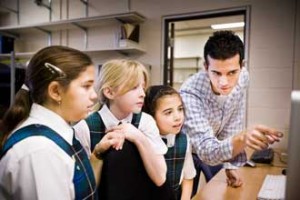
Grade 4 ECS students learn about muscle function during lab visit
By Jim Hynes
In a group of six students, six hands shoot up immediately at the question, “Who wants to go first?” This display of academic eagerness is easier to comprehend when you know the students are from a visiting Grade 4 class from Miss Edgar’s and Miss Cramp’s School (ECS) and that they are volunteering to “go first” on one of the robots in Professor David Ostry’s motor control lab in the Department of Psychology.
The 18 students, including Ostry’s daughter Micaela, are studying the human body and its systems in teacher Marie-Hélène Lemay’s science class this year. After Ostry heard they were also discussing muscle function, he offered to show them around his lab, which uses robots to study how the brain controls movements, the movements themselves, and how people interact with tools. Two research projects dominate the work currently being done in the lab: one dealing with human arm movement, and one with speech production.
“Professor Ostry offered to put together three activities related to muscles and muscle movement,” Lemay said. “It was an offer we couldn’t refuse. Apart from the fact that the research being done here has to do with muscle function, it also allowed the girls to be in contact with researchers, to see, touch and try the tools they work with, and also learn about practical uses of studies on the human body. I think all of that makes for a very enriching experience for the students,” she said.
“This stuff is really compelling for kids,” Ostry said. “Just getting to see, getting to play with robots and see how muscles work. It really gives them this exposure to science that is really important in developing an interest.”
The students took in four experiments, including a robotic arm that applies force to the user’s arm and lets the researchers see how people adapt. One of the more popular stations tracked arm movement through the use of sensors such as those used to make digital animation films. On a separate computer monitor, the students were also able to view a before and after sequence from the film Pirates of the Caribbean that was created using the same technology. Most thought that that as pretty “cool.”
Yes, “cool” was used more than once – not just by the students.
“The thing that’s closest to what they’re learning in class is the muscle activity work,” Ostry said. “In class they learned about the action of opposing muscles. So the experiment where they get to see and listen to muscle activity is closest to what they’ve experienced,” he said. “But playing with robots of course is so cool.”
